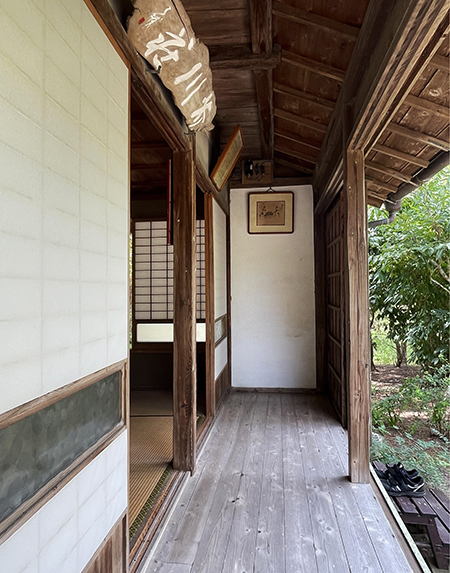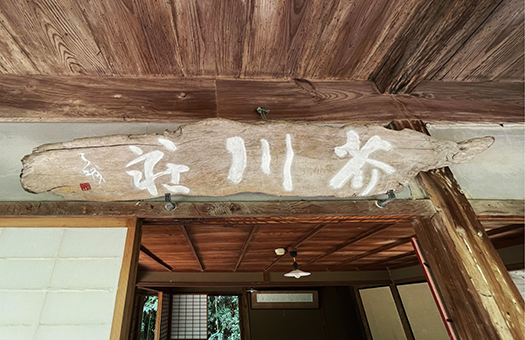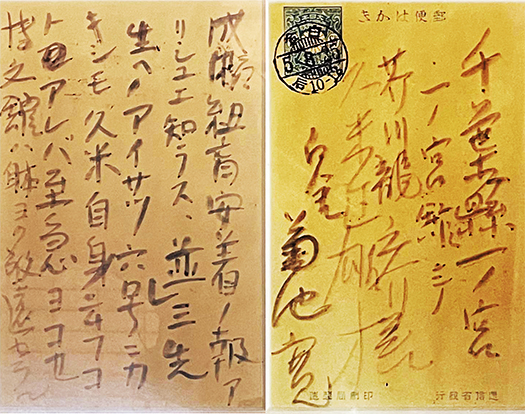


こちらの「芥川荘」を見学したいと旅館本館を訪れたところ、女将さんとおぼしき方がいらっしゃって、どうぞ見学ください、だけど台風に備えて雨戸を全部閉め切っていますから、申し訳ないがご自分で開けて、ご自由にごらんください、というありがたい申し出。
その傑作小説に深く親しんできていた作家の恋文執筆の地、という興味が強かったので、まずはその恋文を樹間の碑でしっかり読破させていただいた後、若き25才の文豪が滞在した「離れ」に。
建築としてのこの庵はまことに温暖・蒸暑地らしい建物。本体の図面などは見当たらなかったけれど、八畳2間に3方向が縁が回っている建築。屋根は茅葺きで庇部分が張り出している。たぶん南国的な気候で時雨が多く、その対応なのでしょう。茅葺きは結構重厚ですが、もちろん夏期の日射による室内気温上昇を抑制したいというのが主目的。冬期も零下までの気温低下は考えにくい地域性なので、まさに夏を旨とした日本文化的軽量建築。
杭基礎が表れていて、床下は全開放されて蒸暑気候の中での耐久性を考え、通風最重視という考え方がよく表れている。太平洋・九十九里の浜辺らしく地面は砂地であることがあきらかで、杭基礎は多少不同していて、縁の部分など、多少の不同沈下が見られています。でも、建物自体が軽量な造作なので確実に築100年は超えているけれど、乾燥状態が保たれた建物と目視できます。

東大在学中からその文才を認められて作家として人生をスタートさせるというのは、その後、大江健三郎がその後嗣になって日本文学作家の一典型にもなった経歴。しかも芥川の場合は終生の師と仰いだ夏目漱石の激賞を受けたばかりという時期。チョー恵まれた環境で人生を歩み始めた天才の、輝かしい時期にこの海浜の庵への逗留時期が重なっている。太陽の季節。
夏目漱石の時代は明治国家としてあらゆる産業勃興させ、社会を欧米近代に追いつかせることに全力だった時代。そういうかれの世代の心理から、芥川のような天才の文学の仕事が日本社会文化創造に欠かせないと判断された時代だったのでしょう。
室内にはこの時期の交友関係が示された手紙・ハガキが展示されていて、上の写真は菊池寛からのハガキ文面。おおむね2週間程度の芥川の滞在期間中にのちの「文藝春秋社」創設者・菊池寛からハガキが来ているということは、のちの菊池寛と芥川の関係をも予測させる。わたしの推量としては「作品制作の場」として滞在費を出資し新進気鋭の作家を「缶詰め」にして作品執筆に当たらせる文化の初源期か?
建物はいかにも温暖地の開放型住宅らしくて北海道人には、夢のようなパラダイス気候環境を想起させてくれる(笑)。「こんなのでも冬,たいして寒くないんだ」という気候条件そのものに対して強く感受性が反応して、いわば底抜けの日本的な心理的解放感を見ておりました。
そういう日本の温暖・蒸暑地らしい住宅建築の「いごこち」についてちょっと考えてみたいので、明日以降、この庵の住宅環境を掘り下げて見たい。
English version⬇
Warm climate seaside “ventilation-oriented” light architecture Ryunosuke Akutagawa’s Hermitage in Kujukuri – 4
From the point of view of the people of Hokkaido, this is a dazzlingly blessed climatic environment blessed with the “season of the sun. I would like to delve deeper into the “comfort” of this environment.
When I visited the main building of the ryokan to see “Akutagawa-so,” the proprietress kindly offered me a tour of the house but told me that she had closed all the shutters in preparation for a typhoon.
I was very interested in the place where the writer, who was deeply familiar with the masterpiece novel, wrote his love letter, so I first read the love letter carefully at the monument in the tree house, and then went to the “detached house” where the young 25-year-old literary great stayed.
The hermitage as an architectural structure is truly typical of a warm and humid place. I could not find any drawings of the main structure, but it is a two roomed house with three sides of a rim. The roof is thatched with overhanging eaves. This is probably a response to the tropical climate and frequent rainfall. The thatch is quite massive, but of course the main purpose is to control the rise in indoor temperature due to solar radiation in the summer. Since it is hard to imagine temperatures dropping below zero even in winter in this region, this is a Japanese cultural lightweight building designed for the summer.
The pile foundation is evident, and the under-floor space is fully open to allow for durability in the hot and humid climate, and to emphasize ventilation. The ground is obviously sandy, as is typical of the Pacific and Kujukuri beaches, and the pile foundations are somewhat uneven, with some unequal settling, such as at the edges. However, the building itself is of lightweight construction, so although it is certainly over 100 years old, it can be visually recognized as a building that has been kept in a dry state.
Akutagawa’s literary talent was recognized while he was still a student at the University of Tokyo, and he began his life as a writer, a career that later became typical of Japanese literary writers when Kenzaburo Oe became his successor. In Akutagawa’s case, he had just received a great award from Soseki Natsume, whom he looked up to as a mentor for the rest of his life. The time of his sojourn at the seaside hermitage coincides with a brilliant period in the life of a genius who began his life in a very privileged environment. The season of the sun.
Soseki Natsume’s era was the Meiji era, when the Meiji nation was doing everything in its power to make all kinds of industries flourish and society catch up with the Western modern era. The psychology of his generation probably led him to believe that the literary work of a genius like Akutagawa was indispensable for the creation of Japanese society and culture.
The photo above shows a postcard from Hiroshi Kikuchi. The fact that Akutagawa received a postcard from Hiroshi Kikuchi, founder of Bungeishunju-sha, during his two-week stay suggests that Kikuchi’s publishing company financed Akutagawa’s stay as a “place to create works” and allowed the up-and-coming writer to write his works “in the can.
The building itself is a warm-weather, open-plan residence that evokes for Hokkaido residents a dreamlike paradise climate (laughs). (Laughs.) I felt a strong sensitivity to the climatic conditions themselves, and saw a sense of psychological liberation that is uniquely Japanese, so to speak.
I would like to think a little about the “comfort” of housing architecture that is typical of such a warm and humid climate in Japan, so from tomorrow onward, I would like to delve into the housing environment of this hermitage.
Posted on 10月 9th, 2023 by 三木 奎吾
Filed under: 住宅取材&ウラ話, 日本社会・文化研究







コメントを投稿
「※誹謗中傷や、悪意のある書き込み、営利目的などのコメントを防ぐために、投稿された全てのコメントは一時的に保留されますのでご了承ください。」
You must be logged in to post a comment.